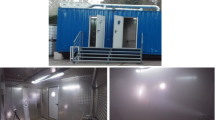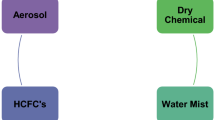Abstract
Counterfog is a new, rapid response system for collapsing all kinds of dispersed agents (smoke, fog, spores, etc.) by using a fog made of a solution that could contain any kind of neutralizing component. Tests in the Fog Dynamics Laboratory with surrogates of biological agents have been carried out. The results show that the new Counterfog technology is able to decontaminate the air with a minimal use of harmless, low-cost, and eco-friendly resources.
Access this chapter
Tax calculation will be finalised at checkout
Purchases are for personal use only
Similar content being viewed by others
References
Ijaz, M.K., Zargar, B., Wright, K.E., Rubino, J.R., Sattar, S.A.: Generic aspects of the airborne spread of human pathogens indoors and emerging air decontamination technologies. Am. J. Infect. Control. 44(9), S109–S120 (2016)
Li, Y., Tang, J., Noakes, C., Hodgson, M.J.: Engineering control of respiratory infection and low-energy design of healthcare facilities. Sci. Tech. Built Environ. 21(1), 25–34 (2015)
Raber, E., Hirabayashi, J.M., Mancieri, S.P., Jin, A.L., Folks, K.J., Carlsen, T.M., Estacio, P.: Chemical and biological agent incident response and decision process for civilian and public-sector facilities. Risk Anal. 22(2), 195–202 (2002)
International Agency for Research on Cancer. IARC classifies formaldehyde as carcinogenic to humans. http://monographs.iarc.fr/ENG/Monographs/vol88/index.php
Pinnaduwage, P., Schmitt, L., Huang, L.: Use of a quaternary ammonium detergent in liposome mediated DNA transfection of mouse L-cells. Biochim. Biophys. Acta (BBA)-Biomembr. 985(1), 33–37 (1989)
Andersen, B.M., Rasch, M., Hochlin, K., Jensen, F.H., Wismar, P., Fredriksen, J.E.: Decontamination of rooms, medical equipment and ambulances using an aerosol of hydrogen peroxide disinfectant. J. Hosp. Infect. 62(2), 149–155 (2006)
Rogers, J.V., Choi, Y.W., Richter, W.R., Rudnicki, D.C., Joseph, D.W., Sabourin, C.L.K., Chang, J.C.S.: Formaldehyde gas inactivation of Bacillus anthracis, Bacillus subtilis, and Geobacillus stearothermophilus spores on indoor surface materials. J. Appl. Microbiol. 103(4), 1104–1112 (2007)
Buhr, T.L., Young, A.A., Minter, Z.A., Wells, C.M., McPherson, D.C., Hooban, C.L., Crigler, J.R.: Test method development to evaluate hot, humid air decontamination of materials contaminated with Bacillus anthracis Δ Sterne and B. thuringiensis Al Hakam spores. J. Appl. Microbiol. 113(5), 1037–1051 (2012)
Prokop, E.J., Crigler, J.R., Wells, C.M., Young, A.A., Buhr, T.L.: Response surface modeling for hot, humid air decontamination of materials contaminated with Bacillus anthracis Δ Sterne and Bacillus thuringiensis Al Hakam spores. AMB Express. 4(1), 21 (2014)
Buttner, M.P., Cruz, P., Stetzenbach, L.D., Klima-Comba, A.K., Stevens, V.L., Cronin, T.D.: Determination of the efficacy of two building decontamination strategies by surface sampling with culture and quantitative PCR analysis. Appl. Environ. Microbiol. 70(8), 4740–4747 (2004)
Koburger, T., Below, H., Dornquast, T., & Kramer, A.: Decontamination of room air and adjoining wall surfaces by nebulizing hydrogen peroxide. GMS Krankenhaushygiene interdisziplinär 6(1) (2011). https://doi.org/10.3205/dgkh000166
Author information
Authors and Affiliations
Corresponding author
Editor information
Editors and Affiliations
Rights and permissions
Copyright information
© 2018 Springer International Publishing AG, part of Springer Nature
About this paper
Cite this paper
Martín-Pérez, T. et al. (2018). Eco-friendly Air Decontamination of Biological Warfare Agents Using “Counterfog” System. In: Malizia, A., D'Arienzo, M. (eds) Enhancing CBRNE Safety & Security: Proceedings of the SICC 2017 Conference. Springer, Cham. https://doi.org/10.1007/978-3-319-91791-7_14
Download citation
DOI: https://doi.org/10.1007/978-3-319-91791-7_14
Published:
Publisher Name: Springer, Cham
Print ISBN: 978-3-319-91790-0
Online ISBN: 978-3-319-91791-7
eBook Packages: Physics and AstronomyPhysics and Astronomy (R0)




